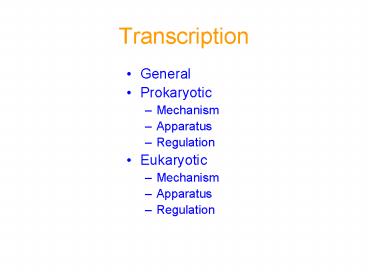Transcription - PowerPoint PPT Presentation
1 / 30
Title: Transcription
1
Transcription
- General
- Prokaryotic
- Mechanism
- Apparatus
- Regulation
- Eukaryotic
- Mechanism
- Apparatus
- Regulation
2
Transcription similar to replication but
different
- RNA polymerases use ribonucleotides (NTPs) and
Uracil instead of Thymine. - Produces single-stranded molecules that are
complementary to one strand of the DNA template
(or non-coding strand). - Only part of the genome is transcribed
functional genome or transcriptome
3
Transcription Basic Enzymology
- DNA-dependent RNA Polymerases
- RNA Pols polymerize in the 5 to 3 direction
(rNTP added only to the 3 end) - 3 OH of chain reacts with the a phosphate of
incoming rNTP, liberating pyrophosphate - Added ribonucleotide follows Watson-Crick
pairing rules, determined by template strand - RNA polymerases dont need a primer, but do need
DS DNA
4
E. coli RNA polymerase
- - 2 copies
- b - 1 copy
- b - 1 copy
- s - 1 copy
Core
holoenzyme
There are multiple forms of s (sigma).
5
Transcription in 4 Steps
- Binding
- Initiation
- Elongation
- Termination
6
1. Binding
- Occurs at promoters
- (-10, -35) or s70 most common type
- Recognized by s70 subunit
- E. coli has at least 2 other promoter types
- Recognized by other s factors
7
Figure 6.8
A Prokaryotic Promoter
Capital letters denote bases found in those
positions 50 of promoters examined. Small
letters
8
Consensus TTGACA 17/- 1bp TATAAT
-35 -10
9
-10
-35
Side view
10
Looking up from below the DNA.
11
The very strong rRNA promoter has an extra
upstream element, UP.
Recognized by the a subunit, strengthens binding
of Polymerase to the promoter.
Fig. 6.9
12
2. Initiation
- Polymerase bound tightly to promoter, Closed
Complex - Polymerase unwinds DNA (-10 to 3), Open
Complex - Starts synthesizing RNA
Fig. 6.7
13
3. Elongation
- After 10 nucleotides have been added, 5 end
ribonucleotide unpairs from template. - The s subunit dissociates from core.
- The size of RNA-DNA hybrid (10 bp) maintained
during elongation. - Sigma recycles to new polymerase molecules.
Fig. 6.14
14
4. Termination
- Two types of termination events in E. coli
- Rho independent
- Rho dependent
- Rho independent also called intrinsic
- Triggered by an Inverted Repeat (IR) that occurs
downstream of Rho independent genes - IR followed by an A-rich region
15
IR in DNA produces a stem-loop in RNA.
16
????????begins to ?????
Stem-loop formation competes with the RNA-DNA
hybrid (Open Complex). Causing DNA helix to
reform (Closed complex).
????????????? and Destabilizes hybrid (RNA
Pull-out)
???????????
Fig. 6.51
17
Rho-dependent termination
- Rho is a RNA helicase, and an ATPase
- Travels along RNA chasing polymerase
- When polymerase stalls at an IR (no A-T rich
region), Rho dissociates the RNA-DNA hybrid - DNA helix closes
18
Rho in action
Rho is a hexamer helicase, like DnaB except
prefers RNA.
Rho binds transcripts at stretches of 100 nt
free of 2nd structure and rich in cytosines.
Can unwind RNA-DNA hybrids.
Fig. 6.56
19
Closer look at the Prokaryotic RNA Polymerase
Sigma factors
- There are 7 sigma factors in E. coli differ in
their affinity for the Core enzyme. - They dont all recognize the same promoters
either. - Sigma factors are themselves regulated, e.g.,
- ?32 becomes activated by heat shock (42C).
- Displaces ?70 from the core.
- Directs the RNAP to heat-shock promoters.
20
Conserved regions of sigma factors
2.1 - Core binding 2.3 - DNA melting 2.4 -
(-10) recognition
4.1 - Activators bind 4.2 - (-35) recognition
Polymerase core has non-specific affinity for DNA
that is reduced by ? factors, thereby promoting
specific binding.
21
Figure 6.5
22
Function of s
- Provides promoter specificity
- Increases affinity of RNA Pol for promoter
- Allows transcription initiation
- Stimulates transcription initiation,
- not elongation
23
What are the functions of the other subunits of
the E. coli RNAP?
Identifying the active site.
24
Drugs that inhibit E. coli RNAP
- Rifampicin - blocks at initiation (Open Complex
forms), rifampicin resistance mutations mapped to
the b subunit. - Streptolydigin- inhibits elongation stage,
resistance mutations also map to b subunit. - What do initiation and elongation have in common?
Phosphodiester bond formation. Suggests ß subunit
is key.
25
Fig. 6.33
Direct evidence for ß active site by Affinity
Labeling.
(1) Reagent in (a) resembles ATP, but it reacts
with NH2 groups when binds to active site. (2)
Then add radioactive a -32P-UTP, which is added
(i.e., polymerized) onto reagent I.
26
(3) Separate enzyme subunits by
SDS-polyacrylamide gel electrophoresis, and see
which ones are radioactive. Only the b subunit
is highly radioactive. b subunit must have
active site.
Fig. 6.33
27
E. coli RNA polymerase (redux)
- Functions of other subunits
- a - binds the UP element found upstream of very
strong promoters (rRNA), and activators. - b - active site of Pol, also binds nascent RNA,
RNA-DNA hybrid, and DS DNA in front of the
bubble. - b also binds nascent RNA, RNA-DNA hybrid, and
DS DNA in front of the bubble.
28
Nudler et al., 1998, Science 281, pg. 425
29
RNAP Backsliding and Editing
- If wrong nucleotide incorporated, elongation can
become arrested. - Backsliding now competes with elongation
- Pol backs up, extruding some of nascent RNA
- Gre proteins activate RNAP core to cleave small
piece that has wrong nucleotide. - Pol starts elongating again.
30
RNAP core
Square is the next NTP to be added. Green
nascent RNA that will be cleaved off Red
older RNA













![11 Do’s and Don’ts of Audio Transcription [Infographic] PowerPoint PPT Presentation](https://s3.amazonaws.com/images.powershow.com/7872975.th0.jpg?_=20150713055)

















